Abstract
Matching theory is a mathematical account of behavior, many aspects of which have been confirmed in laboratory experiments with nonhuman and human subjects. The theory asserts that behavior is distributed across concurrently available response alternatives in the same proportion that reinforcement is distributed across those alternatives. The theory also asserts that behavior on a single response alternative is a function not only of reinforcement contingent on that behavior, but also of reinforcement contingent on other behaviors and of reinforcement delivered independently of behavior. These assertions constitute important advances in our understanding of the effects of reinforcement on behavior. Evidence from the applied literature suggests that matching theory holds not only in laboratory environments, but also in natural human environments. In addition, the theory has important therapeutic implications. For example, it suggests four new intervention strategies, and it can be used to improve treatment planning and management. Research on matching theory illustrates the progression from laboratory experimentation with nonhuman subjects to therapeutic applications in natural human environments.
Full text
PDF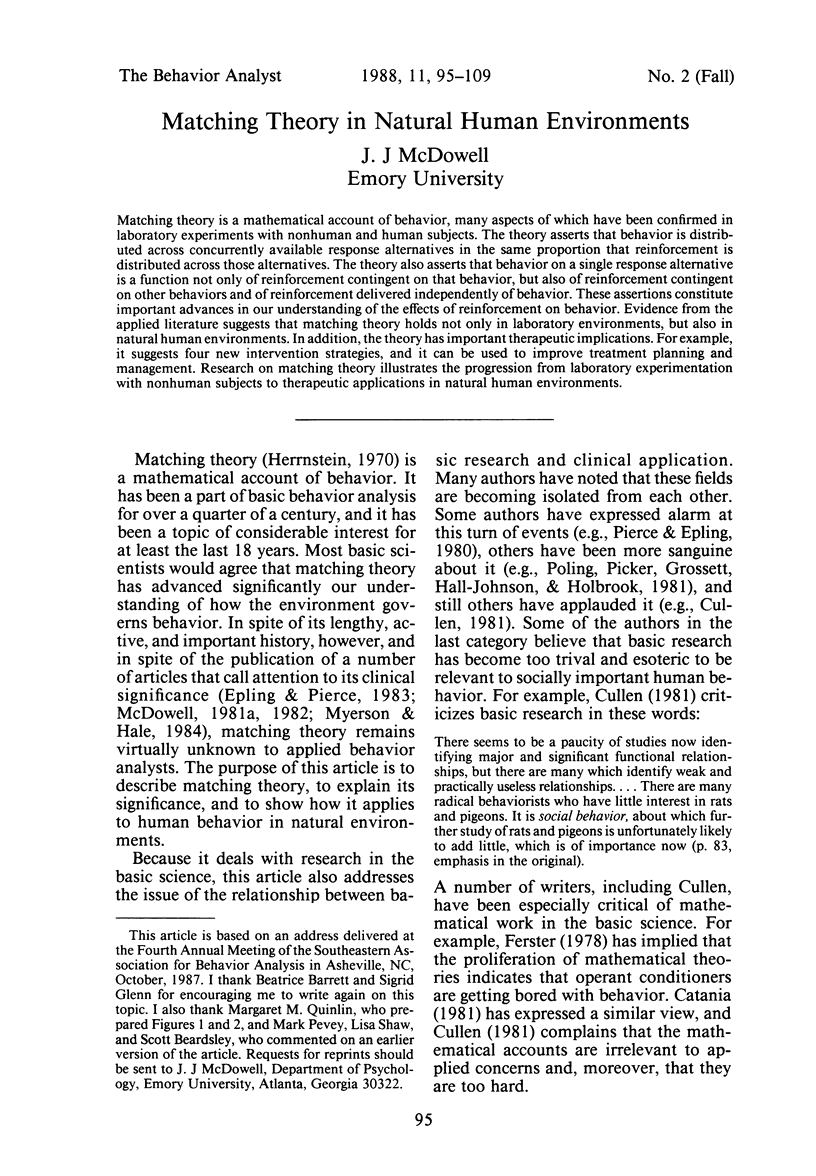
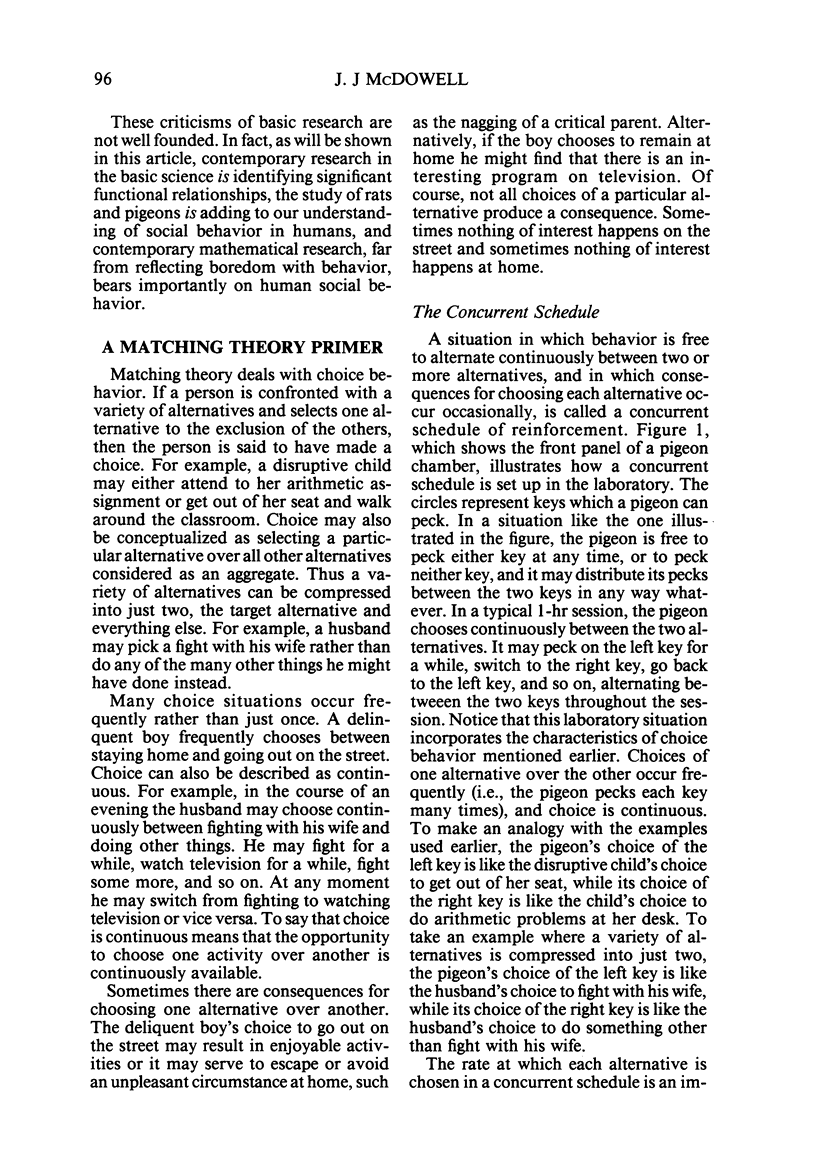


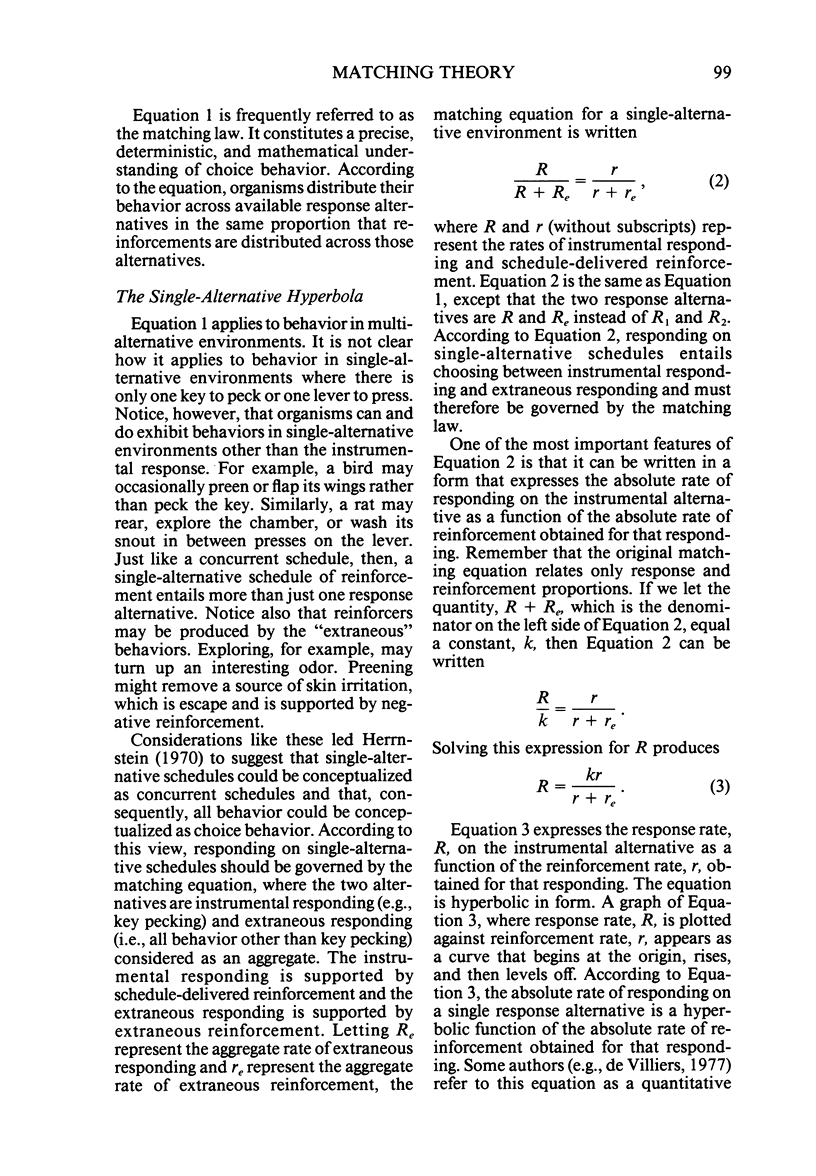
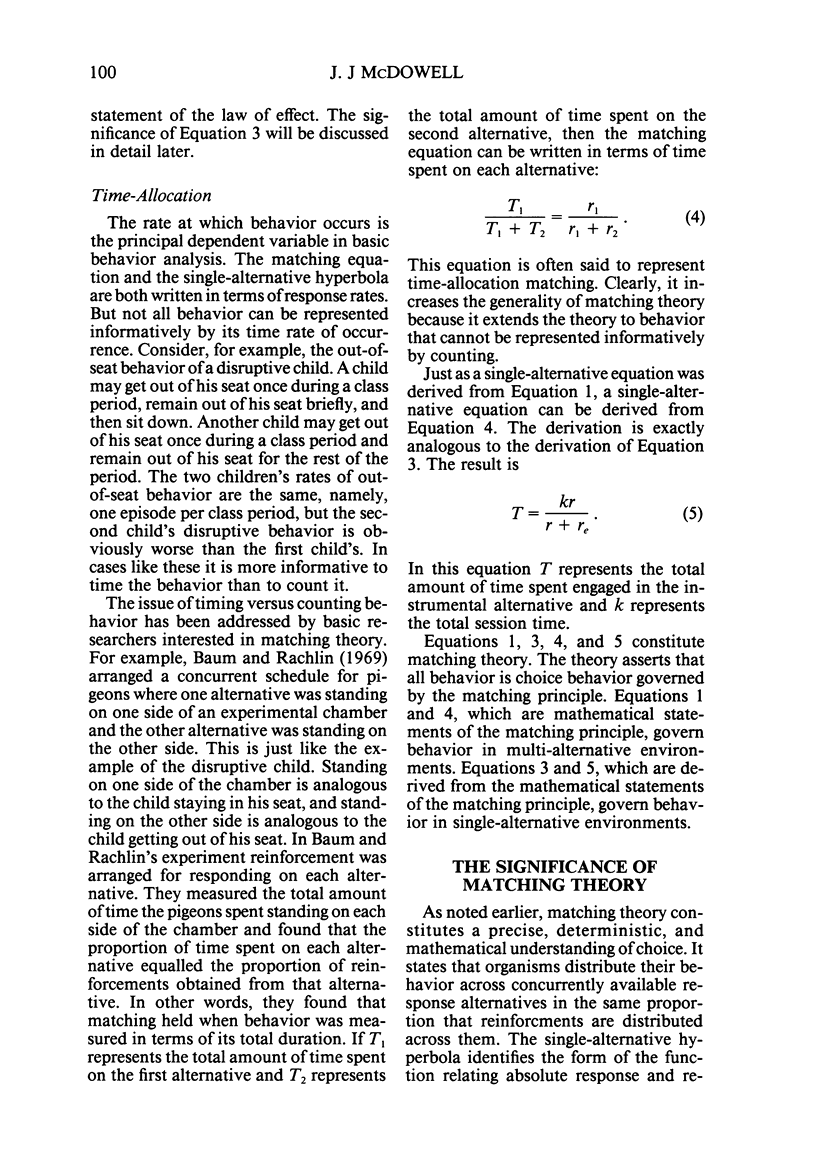
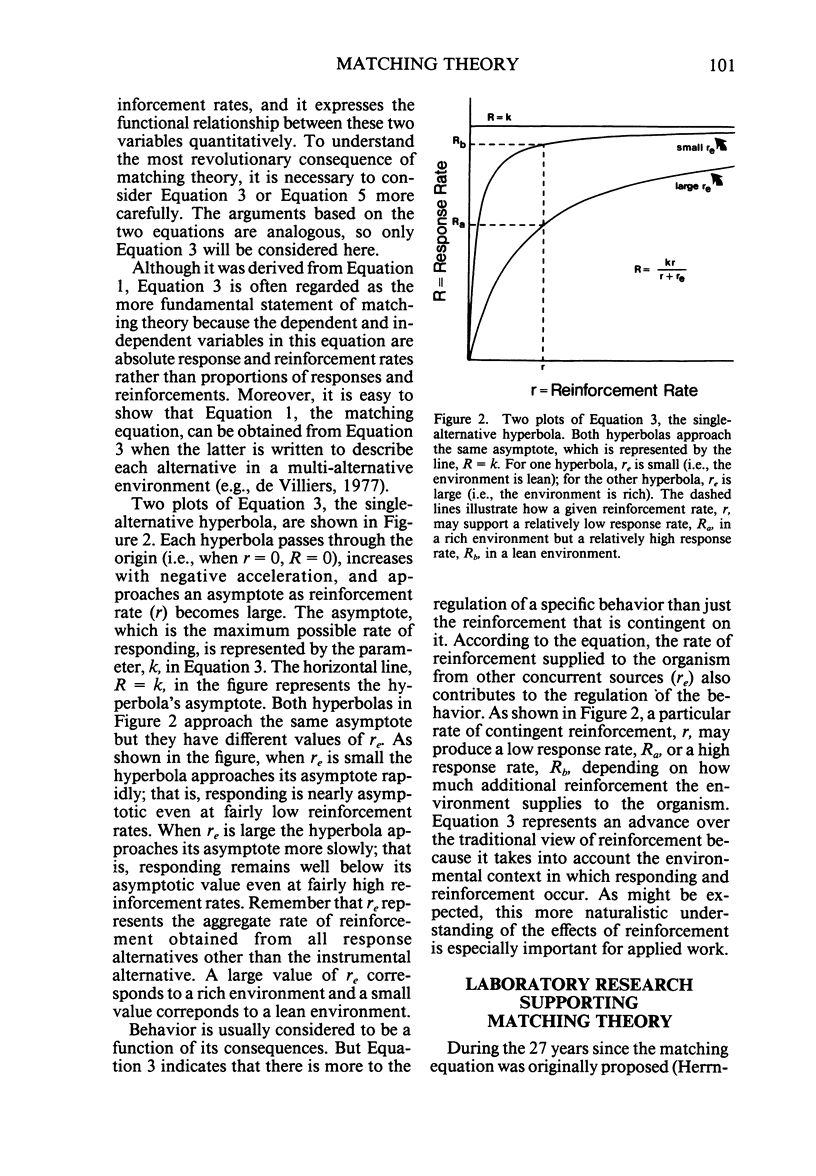
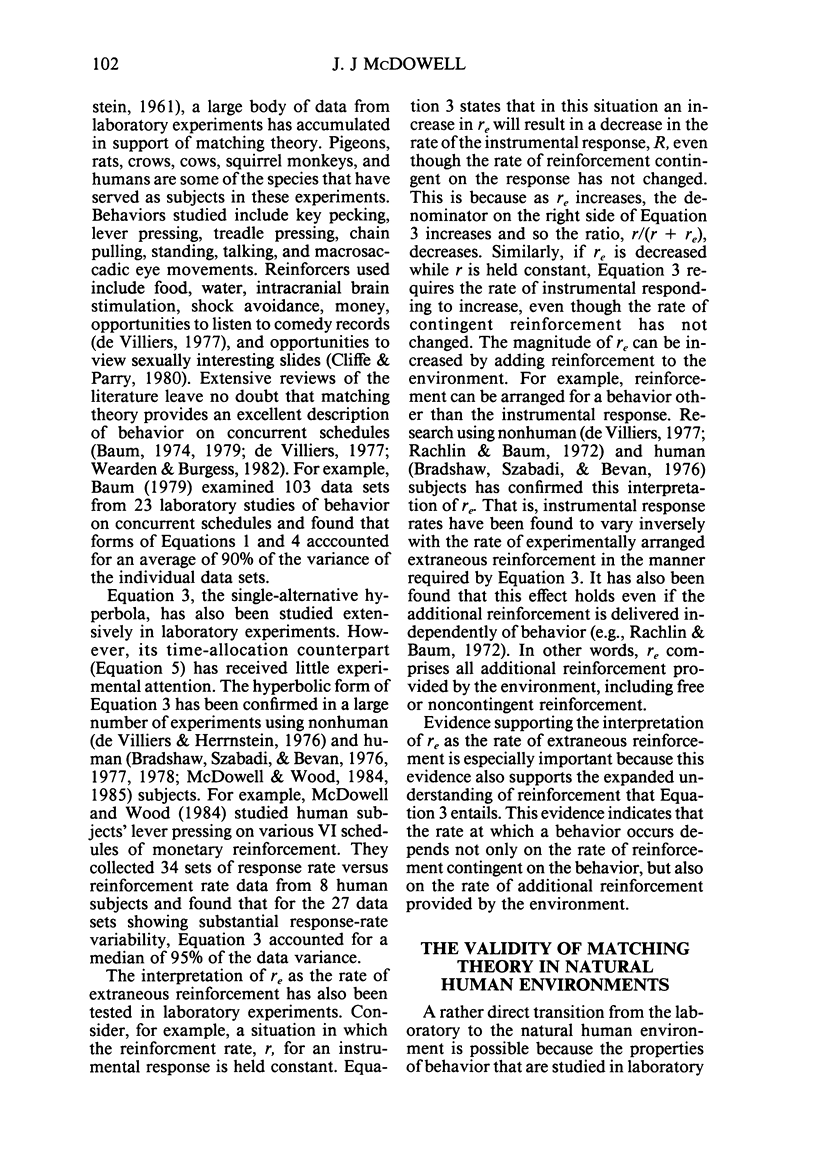
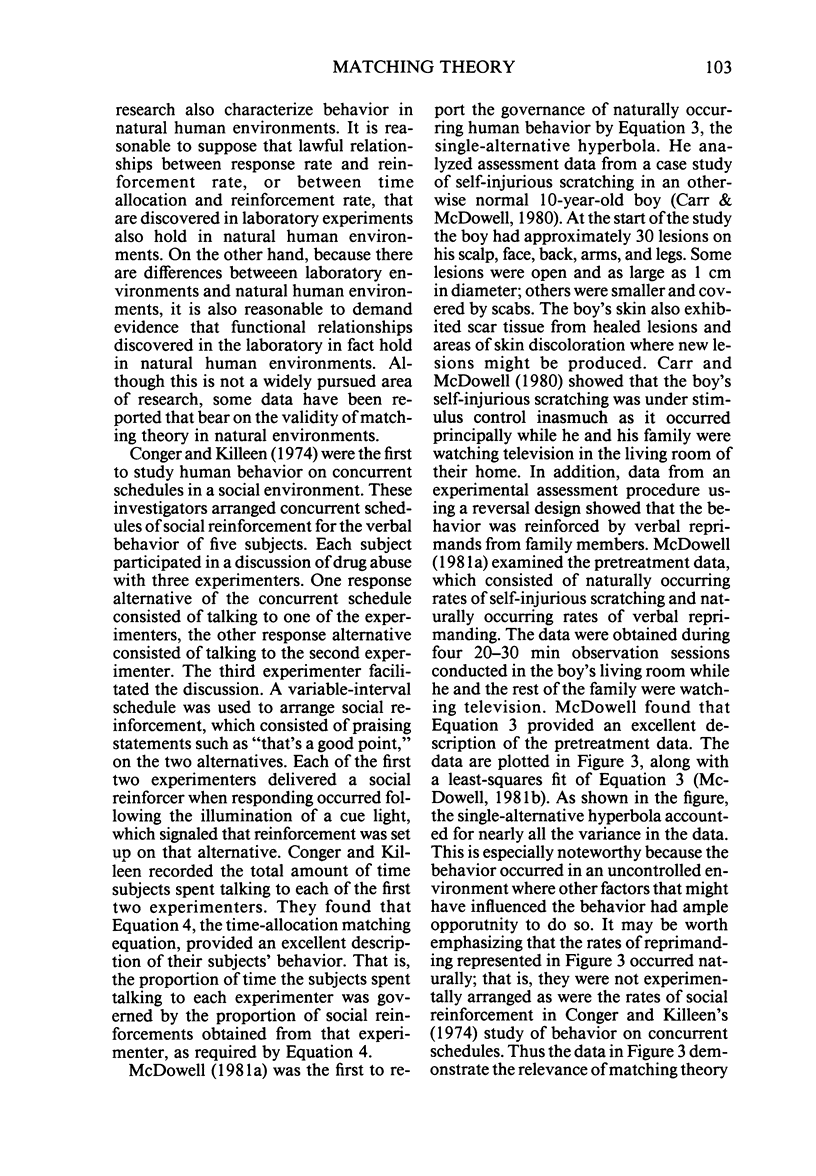
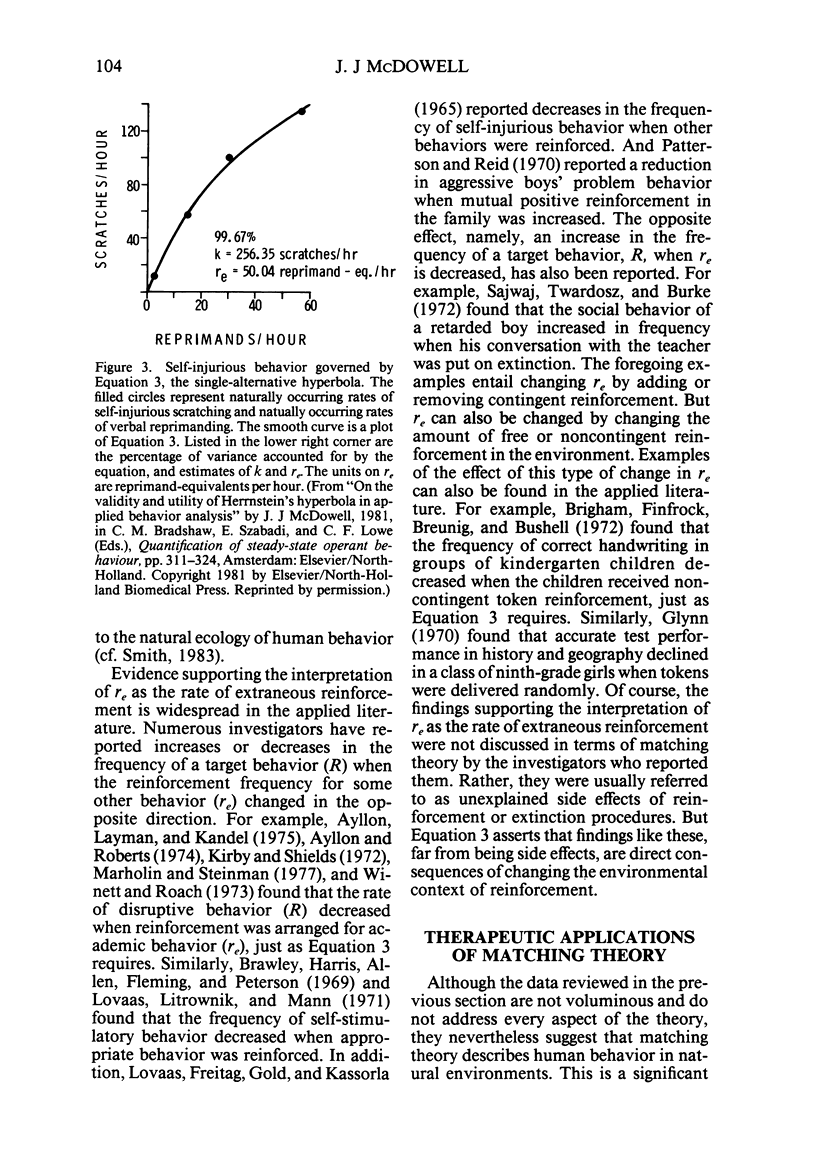
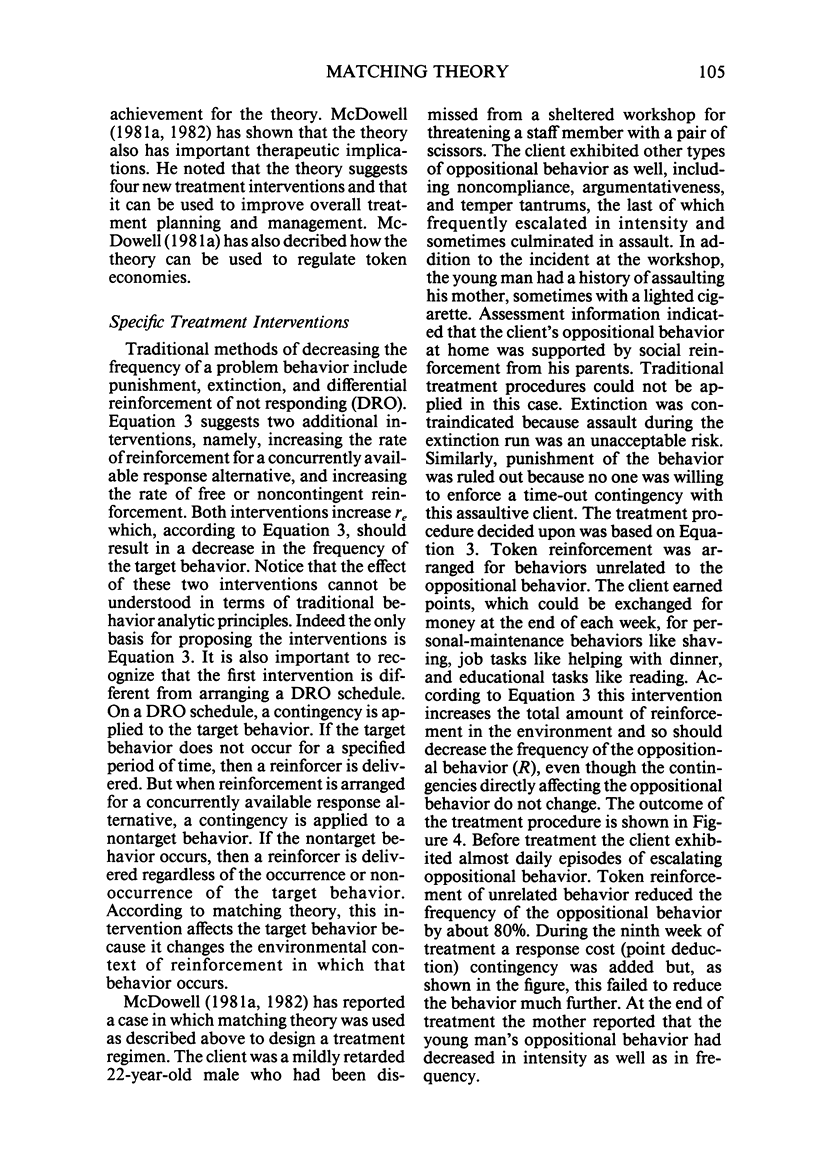
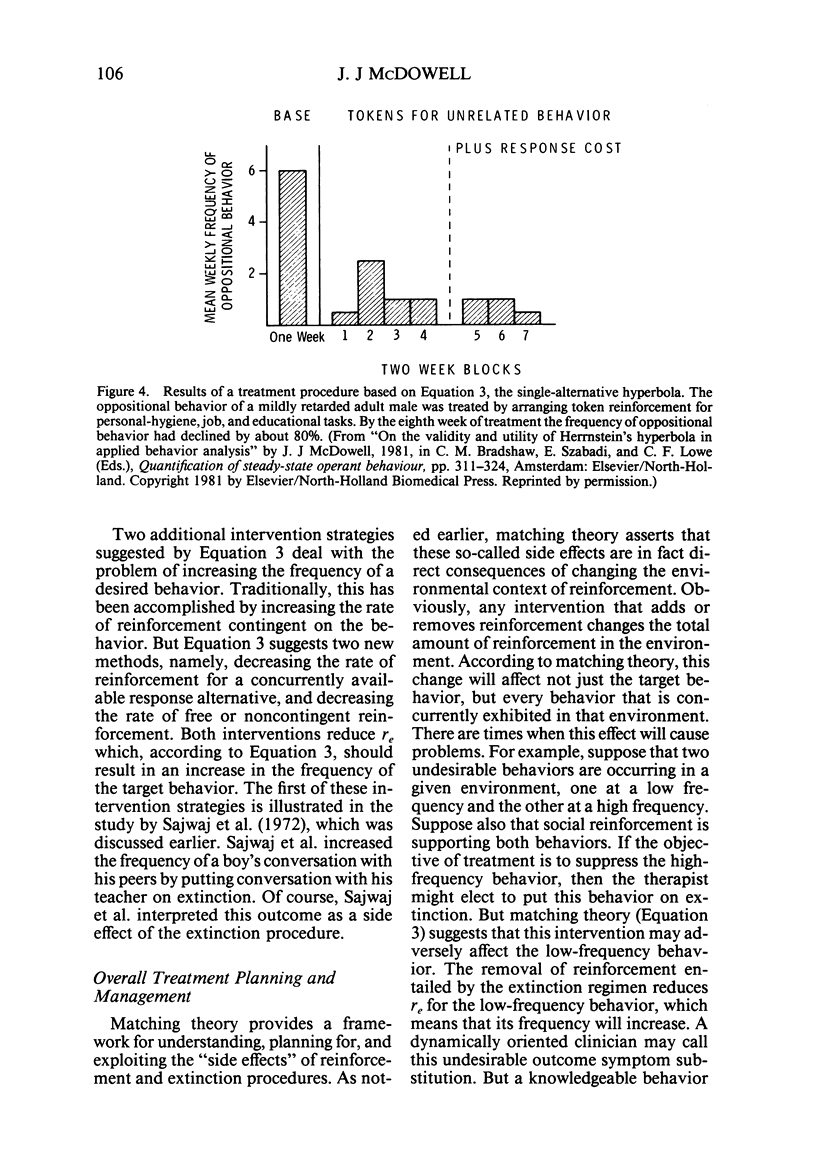
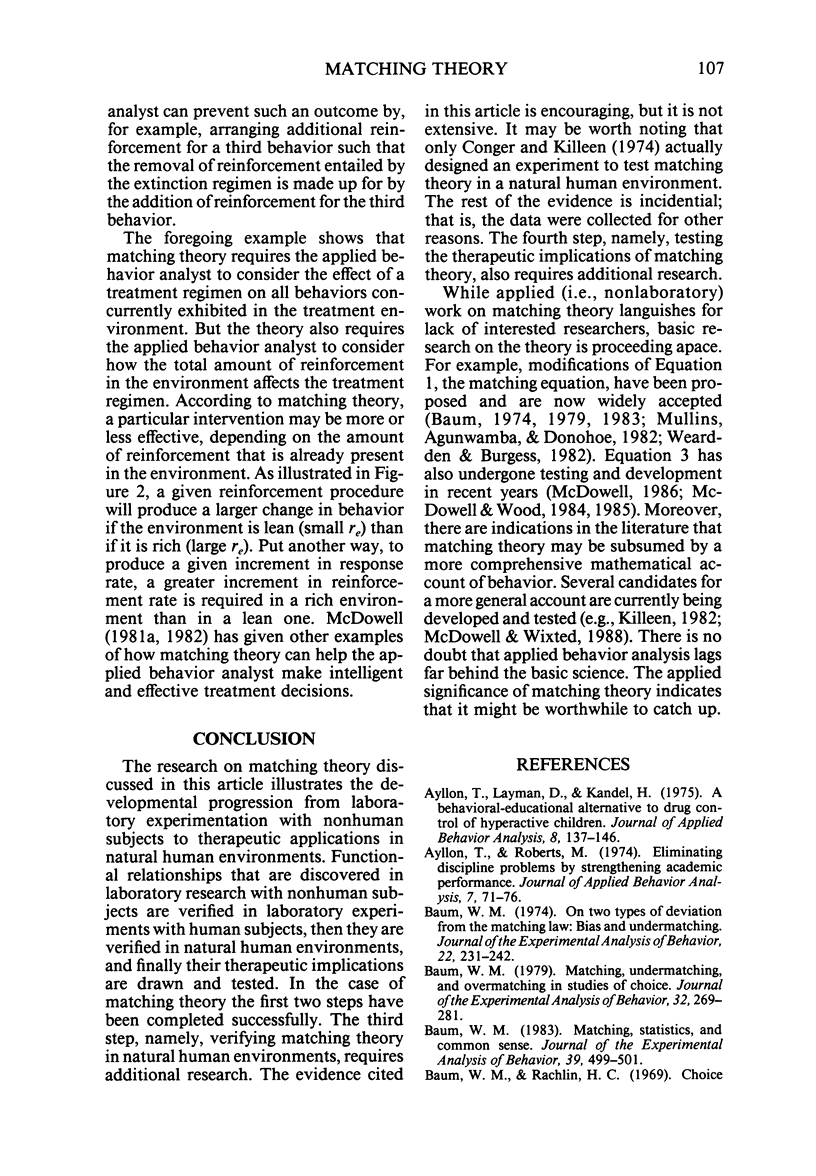
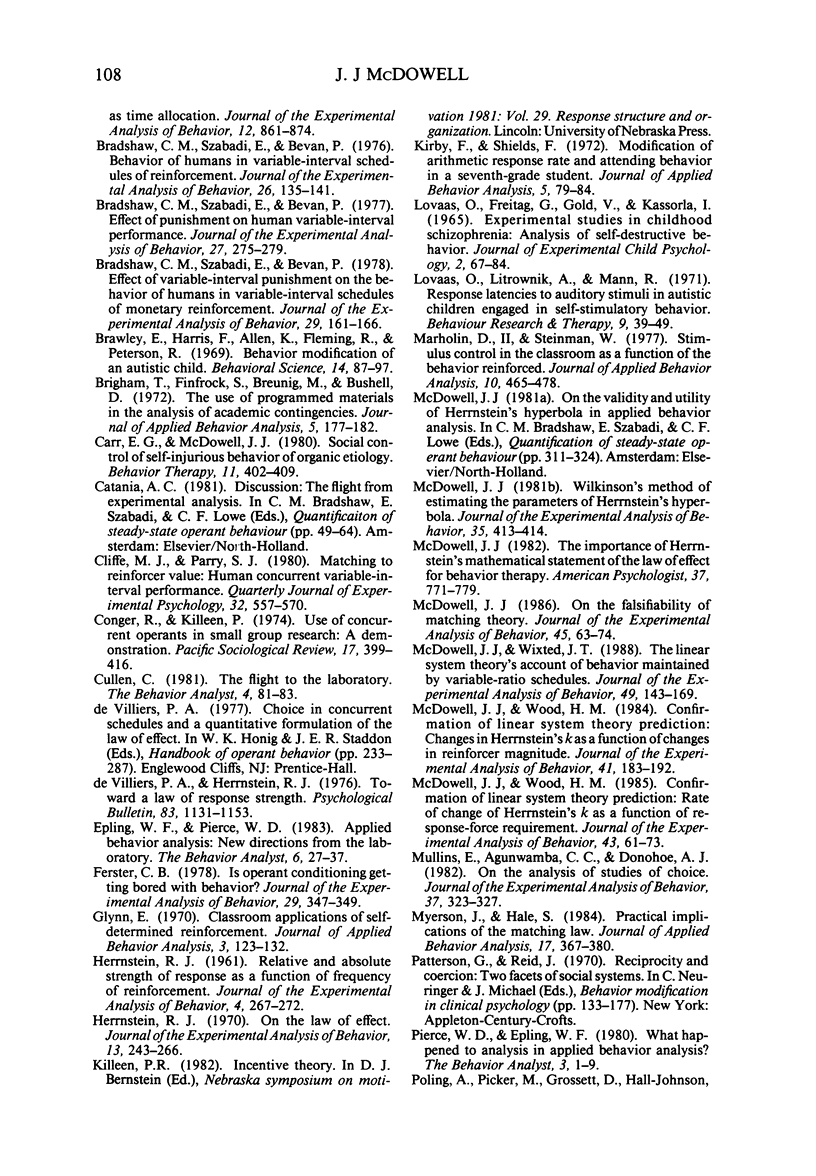
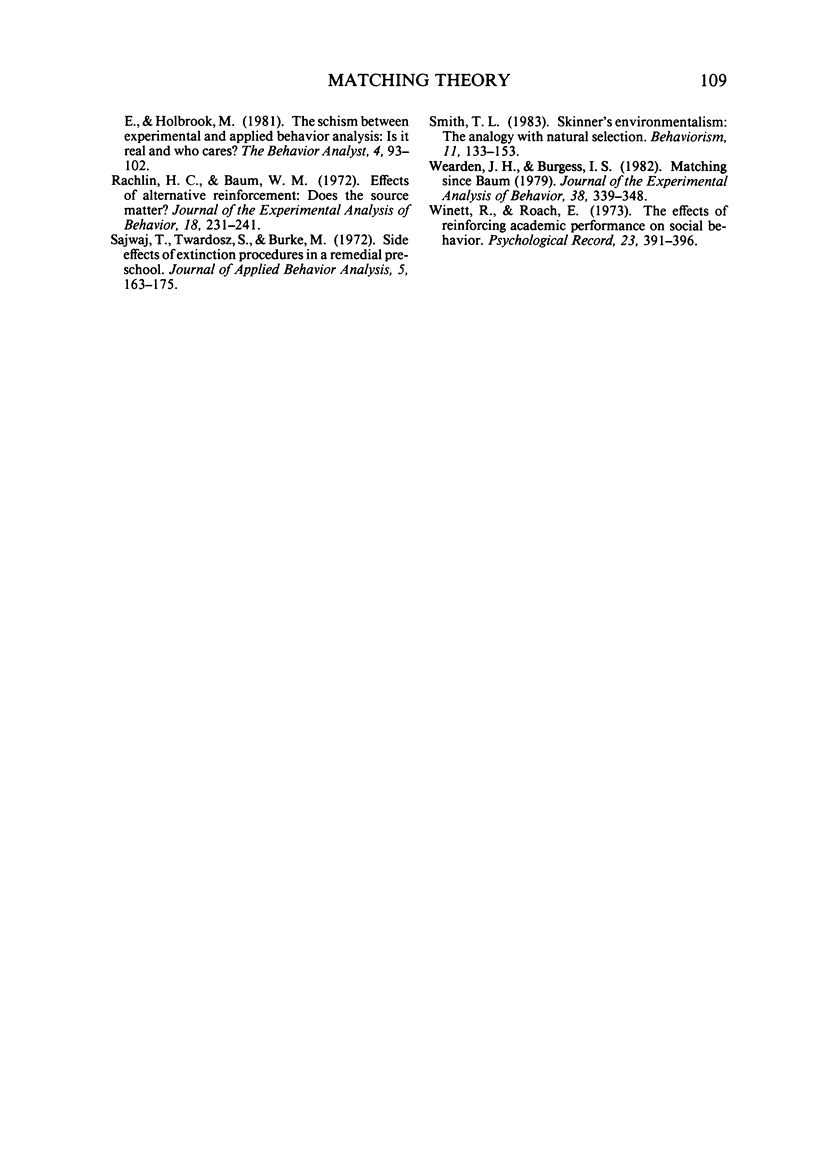
Selected References
These references are in PubMed. This may not be the complete list of references from this article.
- Ayllon T., Layman D., Kandel H. J. A behavioral-educational alternative to drug control of hyperactive children. J Appl Behav Anal. 1975 Summer;8(2):137–146. doi: 10.1901/jaba.1975.8-137. [DOI] [PMC free article] [PubMed] [Google Scholar]
- Ayllon T., Roberts M. D. Eliminating discipline problems by strengthening academic performance. J Appl Behav Anal. 1974 Spring;7(1):71–76. doi: 10.1901/jaba.1974.7-71. [DOI] [PMC free article] [PubMed] [Google Scholar]
- Baum W. M. Matching, statistics, and common sense. J Exp Anal Behav. 1983 May;39(3):499–501. doi: 10.1901/jeab.1983.39-499. [DOI] [PMC free article] [PubMed] [Google Scholar]
- Baum W. M. Matching, undermatching, and overmatching in studies of choice. J Exp Anal Behav. 1979 Sep;32(2):269–281. doi: 10.1901/jeab.1979.32-269. [DOI] [PMC free article] [PubMed] [Google Scholar]
- Baum W. M. On two types of deviation from the matching law: bias and undermatching. J Exp Anal Behav. 1974 Jul;22(1):231–242. doi: 10.1901/jeab.1974.22-231. [DOI] [PMC free article] [PubMed] [Google Scholar]
- Baum W. M., Rachlin H. C. Choice as time allocation. J Exp Anal Behav. 1969 Nov;12(6):861–874. doi: 10.1901/jeab.1969.12-861. [DOI] [PMC free article] [PubMed] [Google Scholar]
- Bradshaw C. M., Szabadi E., Bevan P. Behavior of humans in variable-interval schedules of reinforcement. J Exp Anal Behav. 1976 Sep;26(2):135–141. doi: 10.1901/jeab.1976.26-135. [DOI] [PMC free article] [PubMed] [Google Scholar]
- Bradshaw C. M., Szabadi E., Bevan P. Effect of punishment on human variable-interval performance. J Exp Anal Behav. 1977 Mar;27(2):275–279. doi: 10.1901/jeab.1977.27-275. [DOI] [PMC free article] [PubMed] [Google Scholar]
- Bradshaw C. M., Szabadi E., Bevan P. Effect of variable-interval punishment on the behavior of humans in variable-interval schedules of monetary reinforcement. J Exp Anal Behav. 1978 Mar;29(2):161–166. doi: 10.1901/jeab.1978.29-161. [DOI] [PMC free article] [PubMed] [Google Scholar]
- Brawley E. R., Harris F. R., Allen K. E., Fleming R. S., Peterson R. F. Behavior modification of an autistic child. Behav Sci. 1969 Mar;14(2):87–97. doi: 10.1002/bs.3830140202. [DOI] [PubMed] [Google Scholar]
- Brigham T. A., Finfrock S. R., Breunig M. K., Bushell D. The use of programmed materials in the analysis of academic contingencies. J Appl Behav Anal. 1972 Summer;5(2):177–182. doi: 10.1901/jaba.1972.5-177. [DOI] [PMC free article] [PubMed] [Google Scholar]
- Cliffe M. J., Parry S. J. Matching to reinforcer value: human concurrent variable-interval performance. Q J Exp Psychol. 1980 Nov;32(4):557–570. doi: 10.1080/14640748008401845. [DOI] [PubMed] [Google Scholar]
- Cullen C. The flight to the laboratory. Behav Anal. 1981 Spring;4(1):81–83. doi: 10.1007/BF03391856. [DOI] [PMC free article] [PubMed] [Google Scholar]
- Epling W. F., Pierce W. D. Applied behavior analysis: New directions from the laboratory. Behav Anal. 1983 Spring;6(1):27–37. doi: 10.1007/BF03391871. [DOI] [PMC free article] [PubMed] [Google Scholar]
- Glynn E. L. Classroom applications of self-determined reinforcement. J Appl Behav Anal. 1970 Summer;3(2):123–132. doi: 10.1901/jaba.1970.3-123. [DOI] [PMC free article] [PubMed] [Google Scholar]
- HERRNSTEIN R. J. Relative and absolute strength of response as a function of frequency of reinforcement. J Exp Anal Behav. 1961 Jul;4:267–272. doi: 10.1901/jeab.1961.4-267. [DOI] [PMC free article] [PubMed] [Google Scholar]
- Kirby F. D., Shields F. Modification of arithmetic response rate and attending behavior in a seventh-grade student. J Appl Behav Anal. 1972 Spring;5(1):79–84. doi: 10.1901/jaba.1972.5-79. [DOI] [PMC free article] [PubMed] [Google Scholar]
- Lovaas O. I., Litrownik A., Mann R. Response latencies to auditory stimuli in autistic children engaged in self-stimulatory behavior. Behav Res Ther. 1971 Feb;9(1):39–49. doi: 10.1016/0005-7967(71)90035-0. [DOI] [PubMed] [Google Scholar]
- Marholin D., 2nd, Steinman W. M. Stimulus control in the classroom as a function of the behavior reinforced. J Appl Behav Anal. 1977 Fall;10(3):465–478. doi: 10.1901/jaba.1977.10-465. [DOI] [PMC free article] [PubMed] [Google Scholar]
- McDowell J. J. On the falsifiability of matching theory. J Exp Anal Behav. 1986 Jan;45(1):63–74. doi: 10.1901/jeab.1986.45-63. [DOI] [PMC free article] [PubMed] [Google Scholar]
- McDowell J. J. The importance of Herrnstein's mathematical statement of the law of effect for behavior therapy. Am Psychol. 1982 Jul;37(7):771–779. doi: 10.1037//0003-066x.37.7.771. [DOI] [PubMed] [Google Scholar]
- McDowell J. J. Wilkinson's method of estimating the parameters of Herrnstein's hyperbola. J Exp Anal Behav. 1981 May;35(3):413–414. doi: 10.1901/jeab.1981.35-413. [DOI] [PMC free article] [PubMed] [Google Scholar]
- McDowell J. J., Wixted J. T. The linear system theory's account of behavior maintained by variable-ratio schedules. J Exp Anal Behav. 1988 Jan;49(1):143–169. doi: 10.1901/jeab.1988.49-143. [DOI] [PMC free article] [PubMed] [Google Scholar]
- McDowell J. J., Wood H. M. Confirmation of linear system theory prediction: Changes in Herrnstein's k as a function of changes in reinforcer magnitude. J Exp Anal Behav. 1984 Mar;41(2):183–192. doi: 10.1901/jeab.1984.41-183. [DOI] [PMC free article] [PubMed] [Google Scholar]
- McDowell J. J., Wood H. M. Confirmation of linear system theory prediction: Rate of change of Herrnstein's kappa as a function of response-force requirement. J Exp Anal Behav. 1985 Jan;43(1):61–73. doi: 10.1901/jeab.1985.43-61. [DOI] [PMC free article] [PubMed] [Google Scholar]
- Mullins E., Agunwamba C. C., Donohoe A. J. On the analysis of studies of choice. J Exp Anal Behav. 1982 Mar;37(2):323–327. doi: 10.1901/jeab.1982.37-323. [DOI] [PMC free article] [PubMed] [Google Scholar]
- Myerson J., Hale S. Practical implications of the matching law. J Appl Behav Anal. 1984 Fall;17(3):367–380. doi: 10.1901/jaba.1984.17-367. [DOI] [PMC free article] [PubMed] [Google Scholar]
- doi: 10.1901/jeab.1978.29-347. [DOI] [PMC free article] [Google Scholar]
- Pierce W. D., Epling W. F. What happened to analysis in applied behavior analysis? Behav Anal. 1980 Spring;3(1):1–9. doi: 10.1007/BF03392373. [DOI] [PMC free article] [PubMed] [Google Scholar]
- Poling A., Picker M., Grossett D., Hall-Johnson E., Holbrook M. The schism between experimental and applied behavior analysis: Is it real and who cares? Behav Anal. 1981 Fall;4(2):93–102. doi: 10.1007/BF03391858. [DOI] [PMC free article] [PubMed] [Google Scholar]
- Rachlin H., Baum W. M. Effects of alternative reinforcement: does the source matter? J Exp Anal Behav. 1972 Sep;18(2):231–241. doi: 10.1901/jeab.1972.18-231. [DOI] [PMC free article] [PubMed] [Google Scholar]
- Sajwaj T., Twardosz S., Burke M. Side effects of extinction procedures in a remedial preschool. J Appl Behav Anal. 1972 Summer;5(2):163–175. doi: 10.1901/jaba.1972.5-163. [DOI] [PMC free article] [PubMed] [Google Scholar]
- Wearden J. H., Burgess I. S. Matching since Baum (1979). J Exp Anal Behav. 1982 Nov;38(3):339–348. doi: 10.1901/jeab.1982.38-339. [DOI] [PMC free article] [PubMed] [Google Scholar]


